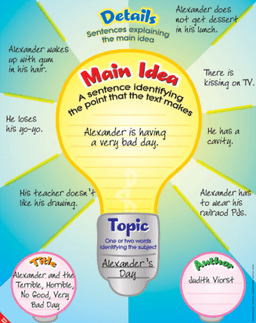Feel free to use or edit a copy
includes Teacher and Student dashboards
Measures 1 skill from
Measures 1 skill from
Track each student's skills and progress in your Mastery dashboards
With a free account, teachers can
- edit the questions
- save a copy for later
- start a class game
- automatically assign follow-up activities based on students’ scores
- assign as homework
- share a link with colleagues
- print as a bubble sheet
4 questions
Show answers
- Q1What is the main idea? The Mole had been working very hard all the morning, spring-cleaning his little home. First with brooms, then with dusters; then on ladders and steps and chairs, with a brush and a pail of whitewash; till he had dust in his throat and eyes, and splashes of whitewash all over his black fur, and an aching back and weary arms. Spring was moving in the air above and in the earth below and around him, penetrating even his dark and lowly little house with its spirit of divine discontent and longing. It was small wonder, then, that he suddenly flung down his brush on the floor, said ‘Bother!’ and ‘O blow!’ and also ‘Hang spring-cleaning!’ and bolted out of the house without even waiting to put on his coat. Something was calling him imperiously, and he made for the steep little tunnel which answered in his case to the graveled carriage-drive owned by animals whose residences are nearer to the sun and air. So he scraped and scratched, working busily with his little paws and muttering to himself, ‘Up we go! Up we go!’ till at last, pop! his snout came out into the sunlight, and he found himself rolling in the warm grass of a great meadow.Springtime makes Mole go stir crazy.Spring cleaning is too hard for Mole.Mole is tired of spring-cleaning and wishes to be outside.Mole worked hard to clean his house during springtime.120sL.1.1h
- Q2What is the meaning of discontent? The Mole had been working very hard all the morning, spring-cleaning his little home. First with brooms, then with dusters; then on ladders and steps and chairs, with a brush and a pail of whitewash; till he had dust in his throat and eyes, and splashes of whitewash all over his black fur, and an aching back and weary arms. Spring was moving in the air above and in the earth below and around him, penetrating even his dark and lowly little house with its spirit of divine discontent and longing. It was small wonder, then, that he suddenly flung down his brush on the floor, said ‘Bother!’ and ‘O blow!’ and also ‘Hang spring-cleaning!’ and bolted out of the house without even waiting to put on his coat. Something was calling him imperiously, and he made for the steep little tunnel which answered in his case to the graveled carriage-drive owned by animals whose residences are nearer to the sun and air. So he scraped and scratched, working busily with his little paws and muttering to himself, ‘Up we go! Up we go!’ till at last, pop! his snout came out into the sunlight, and he found himself rolling in the warm grass of a great meadow.dissatisfiedgloomyunsuremiserable120sL.1.1h
- Q3The text is mainly about – Teens and pre-teens are mostly responsible for cyberbullying because they don’t have their prefrontal cortex fully developed yet until they are 25. Teens, instead, use the amygdala to process information; this is the emotional part of the brain. Teens problem solve and decide emotionally, instead of rationally and long-term thinking. This causes teens to say illicit comments they don’t really mean, or post harmful words with no empathy for what the victim would feel. Anyone can be a target, and anyone can be the one targeting other people. The issue on the internet is that people are more careless when using the internet than the real world. This matters because pre-teens are mostly getting cyberbullied.what happens to teens who are bulliedwhy teens cyberbullywhen teens are targeted on the internetthe development of the teen brain120s
- Q4Who is the author’s intended audience? Teens and pre-teens are mostly responsible for cyberbullying because they don’t have their prefrontal cortex fully developed yet until they are 25. Teens, instead, use the amygdala to process information; this is the emotional part of the brain. Teens problem solve and decide emotionally, instead of rationally and long-term thinking. This causes teens to say illicit comments they don’t really mean, or post harmful words with no empathy for what the victim would feel. Anyone can be a target, and anyone can be the one targeting other people. The issue on the internet is that people are more careless when using the internet than the real world. This matters because pre-teens are mostly getting cyberbullied.administratorsteensteachersparents120sL.1.1h
